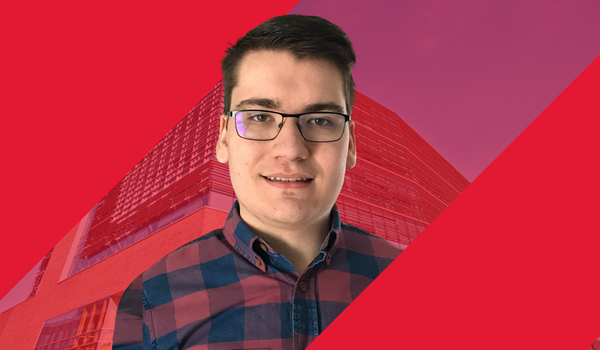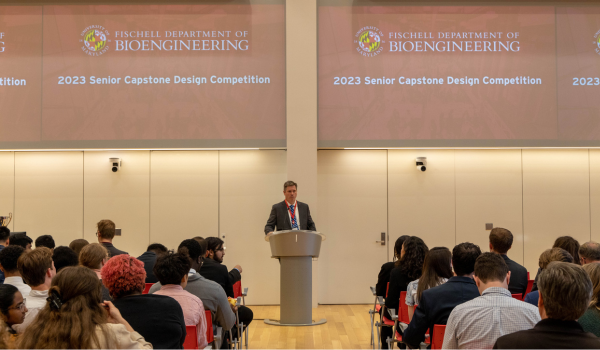Ryan Trask (B.S. '23) is a recent graduate from the Fischell Department of Bioengineering's Biocomputational Engineering undergraduate degree program (BCE). Housed in the Universities at Shady Grove and launched in 2021, the growing BCE program is designed to address the increasing need for engineers who have a solid foundation in both the physical and biological sciences as well as computation and data science.
In this Q-and-A-style Spotlight, Ryan—one of the first students to graduate from BCE— shares his insights and experiences from the program and gives his views on the growing field of biocomputational engineering.
How did you decide to pursue biocomputational engineering?
During my time at Montgomery College, I initially pursued separate interests in biotechnology and engineering, both of which intrigued me. However, I found biocomputational engineering to be the perfect fusion of these passions. Its interdisciplinary nature appealed to me, and I've been committed to it ever since.
How did you learn about biocomputational engineering?
When I was exploring transfer options from Montgomery College, my primary concern was finding an affordable campus to minimize the need for loans and potential debt. Upon discovering the University of Shady Grove's collaboration with the University of Maryland, I realized it offered an economically viable option. As I delved into the available programs, the Biocomputational Engineering program immediately stood out to me, encompassing all the elements I sought in a degree.
What did you look for in a degree?
I sought a degree that offered intellectual challenge while ensuring financial stability. Biocomputational engineering perfectly aligned with these criteria. Moreover, I discovered a high demand for professionals with this degree in various industries, often accompanied by competitive salaries.
How would you describe your learning experience in the Biocomputational Engineering degree program?
Initially, I held a basic understanding of biocomputational engineering, envisioning it as a fusion of biotechnology and coding. However, as I delved into the coursework, I realized its complexity surpassed my initial expectations. The curriculum involved intricate modeling and systemic analysis, prompting frequent inquiries into the coding languages utilized and the techniques applied. I discovered that biocomputational engineering is intricately linked to specialized fields like bioinformatics and biosynthesis, far beyond its perceived simplicity. I was particularly impressed by the program's depth and specialization.
My final semester proved to be the most manageable, owing to the interconnectedness of the courses. Each subject built upon the foundation laid by its predecessors, facilitating a learning experience where knowledge gained in one class directly supported understanding in subsequent ones. The interconnectedness of concepts across courses not only reinforces previous learning but also provides fresh perspectives that deepen understanding. It's comparable to progressing from being a beginner player to mastering a game, as you gain multiple viewpoints on a topic. Biocomputational engineering excels in this aspect by revisiting and reinforcing concepts throughout the curriculum, ensuring a thorough understanding from various perspectives and offering a more comprehensive view of the subject.
What experiences during the semester were most valuable, and how did they impact your understanding of biocomputational engineering?
In my first semester, I was heavily immersed biology and modeling coursework, leading me to believe that the program primarily revolved around constructing and validating models, conducting research, and producing research papers. While these aspects remain pivotal, I soon realized the program's breadth encompassed crucial quantitative components, such as hardware optimization and software development.
Advancements in technology have forced us to integrate our own computational techniques, including the utilization of computing clusters and servers, with machine learning algorithms. Biocomputational engineering stands at the cutting-edge of that, demanding proficiency in machine learning.
What aspects of this program did you find the most challenging and the most rewarding?
I would say this program is project-heavy, but I personally consider this a good thing. The practical nature of the projects mirrors real-world scenarios and aligns closely with the tasks I envision myself undertaking in future roles. During my internship at NIST, I applied the same techniques learned in the program, underscoring its relevance to practical experiences. While these projects can be challenging due to their practical nature, they also serve to challenge and refine one's conceptual understanding, exposing biases in tool usage. It forces you to do things the right way.
How has the program prepared you for graduate schools, real-world applications, or industry experiences?
I mentioned before the projects I did at NIST are the same ones I did here in the program. I feel exceptionally prepared for a career in the field of Biocomputational Engineering. The techniques taught here find application in various industries, including biotechnology, biology-focused fields, and medicine. Additionally, our program places a strong emphasis on scientific research and writing, a skillset essential for publishing articles in academic journals and drafting fundraising proposals. I had the opportunity to write an abstract through the program, leading to participation and recognition at the University of Maryland–Baltimore Campus Oncology Symposium, where our team achieved third place. This was great exposure to the academic world further equipping us for academic pursuits, including graduate school.
How has your understanding of biocomputational engineering evolved from when you first started the program compared to today?
At the beginning, I very much had a simplistic view of the program. I thought we were just going to integrate biology and computer science. But it's so much more than that. I soon discovered its depth and complexity. Biocomputational engineering is about formulating hypotheses about biological and medical phenomena, rigorously testing them, and continuously striving to push boundaries and enhance existing tools. Within the program, students have the flexibility to emphasize either the biological or computational aspects. Personally, I gravitated towards the computational side. The program is inherently self-guided. You get as much as you put in.
How does the BCE program facilitate interdisciplinary collaboration and team work?
Most of the projects in this program are team-based. The professors are very much trying to get the students to talk to one another and work together. As far as the interdisciplinary connections, the biology and computational side are very much interconnected. For instance, during my internship at NIST, I contributed to a project addressing the meniscus effect, which often distorts medical images of small objects like petri dishes. By utilizing the computational expertise, I developed algorithms to correct these images. This collaborative effort resulted in a solution that could enhance future microscope imaging by implementing my neural network as a filter, thereby improving sample quality.
Now that you are a BCE graduate, what are your plans for applying to future jobs, graduate school, or a Ph.D. program?
I'm currently in the process of applying to jobs and have decided to defer graduate school for the time being. My focus is on pursuing computational roles, particularly in the realm of medical imaging, machine learning, and data science. I'm drawn to positions that blend computational expertise with medical applications, reflecting my personal interests and aspirations.
How did the BCE faculty support you as a student?
The advantage of our program lies in its relatively small class sizes, which have facilitated close-knit relationships between students and professors. Over the past two years, I've developed meaningful connections with my professors, which have been invaluable in my academic and professional journey. Whenever I've sought guidance or assistance, my professors have gone above and beyond, even helping me explore potential job opportunities. This experience has underscored the genuine interest my professors have in the success of their students.
What areas in biocomputational engineering do you feel particularly passionate about?
I definitely feel passionate about the machine learning and data science side of things. I'm very much into medical imaging. I like running a machine learning model and pressing the button one day and then seeing the result, and then iterating to try and get the best result. It's sort of like a complex puzzle to me.
How do you think advancements in technology will shape the future of biocomputational engineering?
Advancements in technology are vital to the program. For example, my interest in machine learning would not be possible without the current advancement in computing. As we advance, it's going to become even more important, not just for the computational side but also for biology. Advancements such as DNA synthesis, DNA storage; all of these are possible because computation is advancing at an exponential rate.
What opportunities have you had for internships, research projects, or other practical experiences?
I joined the program in the spring, so I had two summers to gain experience. I engaged in several research projects with Dr. Yousefi. I worked on lung cancer and how to predict how long a person would live based on the data and the condition they had. I also learned from NIST. I learned about medical imaging and the more practical side of things with hands-on experience in real-world applications.
What advice would you give to incoming students interested in pursuing this degree?
When I initially applied, the only misgivings I had was that I was unsure about the math requirements. I was concerned it would be math heavy. However, it wasn't as bad as I thought; it was very much about using math in a practical manner. Each semester got easier because all classes are interconnected. The first semester is the hardest but it gets increasingly easier the more you progress in the program.
Outside of the classroom, what activities do you participate in beyond biocomputational engineering and the STEM world?
I like to play video games. I very much like to sit in a room and immerse myself in the video game world—which is fitting to biocomp, since a lot of jobs require you to go to the office and run models. However, Shady Grove has a lot to offer in extracurriculars and the BCE program also has a lot of networking events.
What accomplishments are you most proud of?
In my final year of the program, I delved into more specialized areas and tools. For instance, utilizing a dataset of chest X-rays from patients, I developed a predictive model for pneumonia with an impressive accuracy rate of 95%. Additionally, my involvement in crafting an abstract for the oncology symposium in University of Maryland–Baltimore County culminated in securing third place, showcasing my proficiency and contributions to the field.
What else would you like prospective students to know about the BCE program?
I want to emphasize the affordability of the program. I am leaving this program with zero debt. I can see a lot of people graduating the same way I did. There's a lot of scholarships available too. There's the merit and demographic based ones, but Shady Grove also has their own scholarships as well. Additionally, we also qualify for University of Maryland–College Park scholarships. There's a lot of opportunities. On a personal note, the program has taught me a lot of values I can incorporate in the professional world such as confidence, organization, and a strong work ethic.



